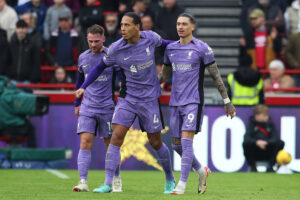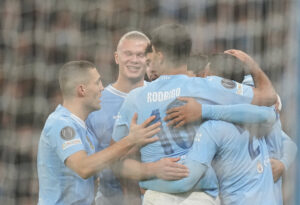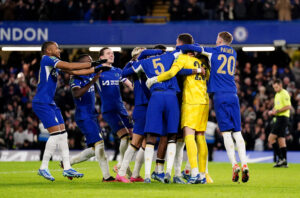For all the improvement that Unai Emery’s Arsenal have shown in recent weeks (their win against Brentford in the Carabao Cup was their sixth in succession in all competitions), against Watford they will face their sternest test since the first two Premier League games of the season against Manchester City and Chelsea, both of which they lost. Watford lack the technical ability and style of City or Chelsea, but they possess strength and tenacity in abundance, particularly in the form of their striking partnership, Troy Deeney and Andre Gray.
Deeney and Gray Will Be a Stern Test For Arsenal
A Flourishing Partnership
Such is the vogue for lone strikers at the moment that Deeney and Gray do not always play together up front, but they will surely do so against Arsenal at The Emirates. That is because they are both the kind of striker that Arsenal central defenders of recent vintage hate to play against: physically strong, good in the air and relentlessly competitive. If either one of them played individually against Arsenal, they would be a threat, but if they both play together they could overwhelm Arsenal’s central defence and undermine all Emery’s good work of recent weeks.
It is obviously still early days in the age of Emery but it is already apparent that central defence remains Arsenal’s greatest weakness, as it was for the second half of Arsene Wenger’s tenure. It is remarkable now to consider that Arsenal were once famed for their centre-backs, from Joe Mercer to Frank McClintock to David O’Leary. Indeed, such was George Graham’s obsession with providing a strong foundation for his team in central defence that he was said to ‘collect’ centre-backs as other people might collect stamps or coins. In addition to the central defensive holy trinity of Adams, Bould and Keown, he also signed quality centre-backs such as Andy Lineghan and even Colin Pates. Central defensive security provided the basis for Graham’s great teams. Indeed, so good were Graham’s centre-backs in particular and his back four in general that they also provided the basis for Arsene Wenger’s first double-winning side in 1998.
Campbell the Great
The last truly great centre-back that Arsenal signed was arguably the most important signing of the entire Wenger era – yes, even more important than Patrick Vieira and Thierry Henry – and that was Sol Campbell. Whatever his limitations on the ball (which were considerable), Campbell combined the aerial ability of a classic centre-half with the speed of a full-back, and in the process provided the defensive security that was the basis of Wenger’s second great Arsenal side (2002-2006). In effect, he allowed the attacking talent of Vieira, Henry, Robert Pires et al to flourish. All those players had been at Arsenal before Campbell arrived, without success; it was Campbell’s signing that completed the jigsaw and made Wenger’s early noughties Arsenal a truly great side.
Since Campbell left in 2006, Arsenal have not signed a truly great centre-back. The closest they have come is Laurent Koscielny, who experienced a fairly poor start to his Arsenal career before maturing into comfortably Arsenal’s best defender. However, even at his best, he could not match the sheer defensive solidity of an Adams or Campbell, and given that he is now 35 and out with injury until Christmas (at least) he is extremely unlikely to become the bedrock of Emery’s new Arsenal.
In Koscielny’s continuing absence, the centre-back resources remain remarkably thin. Shkodran Mustafi has repeatedly shown why he was only ever a squad player when Germany won the World Cup in 2014, as he lacks both the pace and height to ever be a truly dominant centre-half. Even more worryingly, since he moved to England in 2016 he seems to have become a rugby fan, at least judging by his propensity to try and rugby-tackle opposing players around the legs once they have burst past him. He was up to it again this week against Brentford.
Lack of Resources
Arsenal’s two Greek centre-backs, Sokratis Papastathopoulos and Konstantinos Mavropanos, are at opposing ends of the age scale (Sokratis is 30 while Mavropanos is only 20), but neither of them appear fully convincing. Sokratis is physically strong and reasonably good in the air, but is slow on the ground, whereas so little has been seen of Mavropanos that it is impossible to form any kind of definitive judgement about his defensive ability.
That just leaves the two remaining English centre-backs, Rob Holding and Calum Chambers. Holding was superb in the 2017 FA Cup Final defeat of Chelsea, but he has neither played enough nor performed well enough since then to build on that breakthrough performance. And even more perplexing is Arsenal’s treatment of Calum Chambers. He was initially signed in 2014 as a right-back before Wenger tried to turn him into a centre-back. Unfortunately, for all the great attackers who Wenger either discovered or helped to develop, from George Weah to Thierry Henry, the same was never true of his ability to identify a defender, with only Lilian Thuram (an undeniably great defender who Wenger introduced at Monaco) as evidence to the contrary.
What has made the Chambers situation even worse is the club’s continuing insistence on loaning him out at every possible opportunity, first to Middlesbrough (who were relegated from the Premier League while he was with them) and now to Fulham. Even more bizarrely, before he joined Fulham he signed what was announced as a new ‘long-term’ deal to secure his future at the club. Whoever negotiates the players’ contracts at Arsenal frankly deserves to be fired, given that they award ‘long-term’ contracts to players such as Chambers, who do not appear to have a realistic future at the club, while allowing genuine star players, such as Alexis Sanchez and now Aaron Ramsey, to run down their contracts before leaving for free. Arsenal did get Henrikh Mkhitaryan in exchange for Sanchez, but given Mkhitaryan’s overall contribution to Arsenal so far that deal is still the equivalent of letting Sanchez leave for free.
Consequently, after nearly half a century of being regarded as generally the best defensive team in England, especially in central defence, over the last ten years Arsenal have gone in completely the opposite direction and developed a truly unwanted reputation of having the softest of centres. That central defensive weakness will surely be targeted by Watford, and by Deeney and Gray in particular.
A Stern Test Awaits
To be precise, Arsenal can expect a stream of high balls and crosses into their area in open play and at set-pieces. Indeed, set-pieces might be especially problematic, as Watford can boast other tall players who are good in the air, notably Etienne Capoue, in addition to Deeney and Gray. And for all Lucas Torreira’s increasing impact on Arsenal’s defensive play, which has surely been one of the main factors in their recent mini-resurgence, the one thing that Torreira is not is tall. He cannot assist his central defenders as they try to combat high balls and he certainly cannot play as a ‘third central defender’, as Tony Adams sometimes insisted Vieira or Petit did in tough away games, especially at the start.
The situation is not entirely hopeless for Arsenal. After a superb start to the season, Watford have faltered in recent weeks and quite apart from any tactical considerations the current injury doubts about Deeney (especially after he was trodden on by Timothy Fosu-Mensah at Fulham last week) mean that he might just start from the bench at The Emirates. Nevertheless, the likelihood is that both big men will play and Arsenal, for the first time in a long time, will have to find a way to combat the aerial threat of not just one central striker but two. If they can, then it will be the best evidence so far that Emery is at least beginning to tackle the team’s most deep-seated problem.
Main Photo






